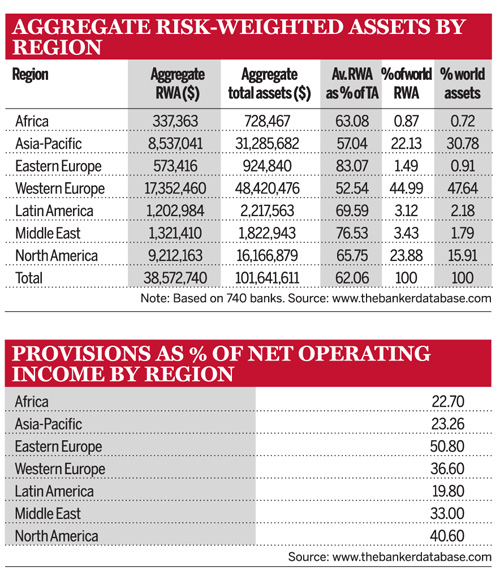While non-performing loan rates give an indication of a bank’s existing asset quality, predicting future trends requires some other indicators.
Provisions are a combination of money put aside to cover current impairments, and expected future impairments. On this basis, Latin America appears to be the region most optimistic about its future, with provisions at less than 20% of operating income, while eastern Europe is the most cautious, with provisions taking up more than 50% of its operating income.
The same caution also shows through another important indicator – assets rated according to their risk under Basel II regulations. Eastern European banks on aggregate count risk-weighted assets (RWA) as 83% of total assets, implying that its financial institutions do not consider much of their asset base to be low-risk. In Latin America, RWAs are just under 70% of the total. These are two regions where lending activity appears to dominate – credit RWAs are more than 90% of the total in both cases, the highest of any regions.
In an uncertain world, eastern European banks should not be criticised for their caution. A high RWA figure and high provisioning mean eastern European banks are better prepared for any future deterioration in asset quality, thus protecting their capital positions.
By contrast, western Europe appears to be hoping for better times. Provisioning is fairly high, at 36.6% (although lower than North America), but RWAs are the lowest for any region, at 53% of total assets. This suggests some deft handiwork from the banks’ accountants, to turn assets worthy of provisioning into assets that have a low-risk weighting.
An example of this could be found by looking at the composition of RWAs. One might think that Asia-Pacific banks are the most exposed to financial markets, with market RWAs at 7.78% of the total. But it seems unlikely that this Asian exposure would really be higher than banks based in the major US and western European financial centres. In fact, for those banks where the data is available, trading securities account for 12% of total assets in western Europe, compared with only 6% in Asia.
This suggests that Asian banks are rigorous in assigning risk weights to financial securities, including the risk of losing more than the initial investment on derivative products (hence market RWAs are a larger percentage of total RWAs than trading securities as a percentage of total assets).
By contrast, western European banks may be accounting for securities as low or zero risk, on the basis that trades can be netted out. This is the classic investment bank model, where the bank acts purely as the intermediary between two clients and takes no risk on its own balance sheet. The financial crisis cast considerable doubt on whether that model of perfect risk transfer really exists.
This data also sheds some light on the rather more physical risks that banks run. Banks in Africa have by far the highest proportion of operational RWAs, encompassing risks such as fraud and damage to their infrastructure.
North American banks have the next highest RWA in this category – perhaps a legacy of the fraud that prevailed in subprime mortgage origination, and the ongoing wave of subprime-related litigation which also falls into this risk category.






